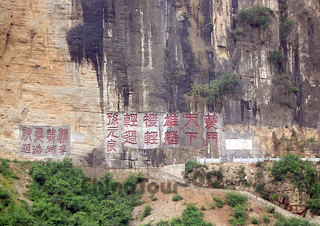 Chalk Wall in Qutang Gorge
Chalk Wall in Qutang Gorge
![]() Chalk Wall
Chalk Wall
Chalk Wall is located on the cliffside of Mount Baiyan of Kui Gate. For more than one thousand kilometers on the wall, there are carved all kinds of Chinese characters, including seal, official script, regular, and running styles.
The earliest inscription was engraved during the Southern Song Dynasty (1127 - 1279), which is an article about the merits and virtues of two emperors, Song Gaozong and Song Xiaozong, written by the famous calligrapher Zhao Gongshuo. The article has 980 characters in total, and was engraved on a four-meter-high and seven-meter-wide stele. Each character on the stele is neat but full of power; every stroke of the Chinese characters was carved delicately. Viewed from a cruise ship, the most catching inscription is "Qu Tang" written by Zhang Boxiang in the Qing Dynasty (1644 - 1911); another Qing-dynasty inscription "Kui Men" was written by Liu Xinyuan in official script. Feng Yuxiang, the Kuomintang general, also expressed his determination of defeating the Japanese army on the wall.
Due to the construction of Three Gorges Project, the water level has risen and would have submerged all the inscriptions. Therefore, all the inscriptions have been moved, and visitors can still see these striking characters on the wall of over 175 meters (574 feet) high.
![]() Phoenix Quaffing Spring
Phoenix Quaffing Spring
Phoenix Quaffing Spring is a stalactite protruding from the rocks near Chalk Wall. The stalactite is 20 meters long and with a diameter of about 6 meters. Looking from distance, it is like a beautiful phoenix dragging her long tails, holding up her head and regaling herself with sweet spring. At the mouth of the "phoenix", another stalactite, like a stream of water, flows down along the neck of the beautiful bird. When it comes to spring, flowers blossoming all over mountains make the phoenix more charming.
![]() Water-Stealing Holes
Water-Stealing Holes
There are a line of holes on the northern cliff of the western end of Qutang Gorge, which are called Water-stealing Holes. The holes were chiseled by Zhang Xianzhong and his troop. It is said at the end of the Ming Dynasty (1368 - 1644), Zhang Xianzhong, the leader of the peasant uprising, united 13 other troops to fight against the Ming government.
Zhang Xianzhong heard that Qutang Gorge was strategically located and difficult to access, and the entrance of the gorge was like a gate, controlling the throat of Sichuan and Hubei areas. Therefore, he led his troops to take over the Baidi City, and set up in the stockade villages on the mountains. The Ming Emperor Chong Zhen thought Zhang Xianzhong might block the connections between Sichuan and Hubei areas, so he ordered his troops to blockade the surface of the Yangtze River and cut off the water sources of the stockade villages on the mountains, so that the peasant troops might surrender.
To get drinking water, Zhang Xianzhong asked his soldiers to chisel a line of holes on the cliff and insert wooden stakes into the holes to make up a simple ladder for soldiers to fetch water from the river. One night, Zhang Xianzhong found a small fish in the water he got. He did not eat the fish but threw it down to the riverside at dawn. When the Ming soldiers saw a lively fish thrown from the stockade village on the mountain, they thought they were not able to cut off the water source of the peasant troops, so they pulled out. Later, Zhang Xianzhong and his troops won a series of battles against the Ming government.
Before the Three Gorges Project was carried out, visitors were able to see the holes from cruise ships. However, the water level has risen due to the project, so all the holes are now submerged.








